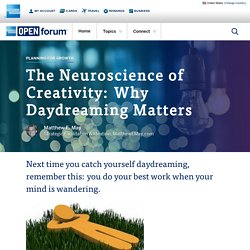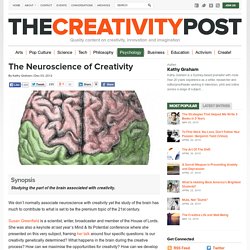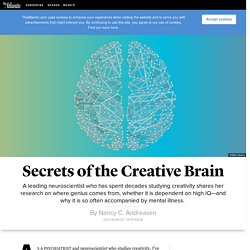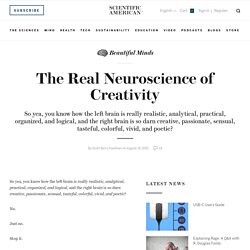

Applying the neuroscience of creativity to creativity training. Applying the neuroscience of creativity to creativity training. The Neuroscience of Creativity: Why Daydreaming Matters. Next time you catch yourself daydreaming, remember this: you do your best work when your mind is wandering.

March 22, 2012 Most people know that 3M's Arthur Fry was not trying to invent the thing he invented in 1974–the Post-it Note–when he was daydreaming in church. As neuroscientists now know, and was conclusively shown in 2009, it’s when our minds wander that our brains do their best work–it's when we’re not trying to think creatively that we’re often most creative. That’s when a still mysterious process in the right hemisphere of the brain behind the right ear makes connections between seemingly unrelated things, and those connections then bubble up as sudden insights, as if out of nowhere. Jonah Lehrer, through our discussion of his just released new book Imagine: How Creativity Works, helped me sort out and make sense out of the latest discoveries, and what the results might imply for anyone wishing to better tap into their natural creativity.
The Neuroscience of Creativity. 155 8Share Synopsis Studying the part of the brain associated with creativity.

We don’t normally associate neuroscience with creativity yet the study of the brain has much to contribute to what is set to be the premium topic of the 21st century. Susan Greenfield is a scientist, writer, broadcaster and member of the House of Lords. She was also a keynote at last year’s Mind & Its Potential conference where she presented on this very subject, framing her talk around four specific questions: Is our creativity genetically determined? Is our creativity genetically determined? The upshot is that each and every one of us has our own unique configuration of brain cell connections shaped by our individual experiences, which in turn are driven by mental processes. That’s her first main point. This is Your Brain on Jazz Improvisation: The Neuroscience of Creativity. It’s clear that amateur saxophonist and Johns Hopkins surgeon Charles Limb has an abiding interest in the neuroscience of creativity.

He’s also an unabashed fanboy. I’ll bet the spirit of scientific inquiry is not the only motivating factor behind this jazz fan’s experiments on jazz improvisers. Sure, he has them play spontaneous variations on a MIDI keyboard in a functional MRI tube in order to study blood oxygen levels in various parts of their brains. But he also gets to hang out in the technologist’s booth, ”trading fours” with captive musician Mike Pope, whom he describes in his TED Talk, above, as “one of the world’s best bassists and a fantastic piano player.” Is this an experiment or a DIY fantasy camp? I’m not sure one needs thousands of dollars’ worth of medical equipment to conclude that improvisation thrives when the inner critic is banished. The same thing happened when a rapper named Emmanuelle was in the tube, free-styling on a set of prompts contained in a rhyme Dr. Speaking of Psychology: The neuroscience of creativity.
Audrey Hamilton: Do you have to be intelligent to be creative?

Can you really learn to be more creative? In this episode, we speak with one neuropsychologist who studies intelligence, creativity and brain function. He talks about why – even if it sounds counterintuitive – intelligence and creativity may not have all that much in common. I’m Audrey Hamilton and this is “Speaking of Psychology.” Rex Jung is an assistant professor of neurosurgery at the University of New Mexico and a practicing clinical neuropsychologist in Albuquerque. Rex Jung: Thank you, Audrey.
Audrey Hamilton: Could you first of all explain neuroimaging and tell our listeners how it helps researchers understand how people think and act? Rex Jung: Sure. A different technique is called diffusion tensor imaging, which allows us to look at water movement in the brain. Audrey Hamilton: Does being highly creative mean you’re also more intelligent? Rex Jung: Not necessarily. Audrey Hamilton: It’s beefed up. Rex Jung: Great. Secrets of the Creative Brain. As a psychiatrist and neuroscientist who studies creativity, I’ve had the pleasure of working with many gifted and high-profile subjects over the years, but Kurt Vonnegut—dear, funny, eccentric, lovable, tormented Kurt Vonnegut—will always be one of my favorites.

Kurt was a faculty member at the Iowa Writers’ Workshop in the 1960s, and participated in the first big study I did as a member of the university’s psychiatry department. I was examining the anecdotal link between creativity and mental illness, and Kurt was an excellent case study. He was intermittently depressed, but that was only the beginning. His mother had suffered from depression and committed suicide on Mother’s Day, when Kurt was 21 and home on military leave during World War II. His son, Mark, was originally diagnosed with schizophrenia but may actually have bipolar disorder. While mental illness clearly runs in the Vonnegut family, so, I found, does creativity. “Doing good science is … like having good sex. The Real Neuroscience of Creativity - Blogs. So yea, you know how the left brain is really realistic, analytical, practical, organized, and logical, and the right brain is so darn creative, passionate, sensual, tasteful, colorful, vivid, and poetic?

No. Just no. Stop it. Please.